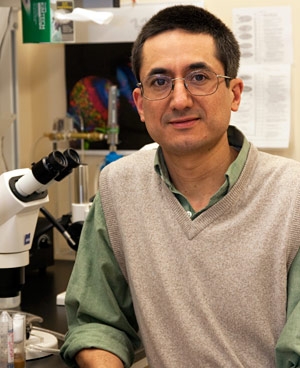
Assistant Professor of Biological Sciences Albert Erives and a team of student researchers have announced a groundbreaking discovery in molecular evolution. The group’s paper, “Dynamic Evolution of Precise Regulatory Encoding Creates the Clustered Site Signature of Enhancers,” appears in the October 19 edition of Nature Communications.
In 2004, Erives and collaborator Mike Levine of the University of California Berkeley discovered a second layer of regulatory code in DNA. The next step was to decipher how this regulatory code worked and how it evolved.
With six years of intensive research, Erives’ Dartmouth team has cracked the code by distinguishing functional elements from elements that were once functional but were superseded during evolution.
Erives’ co-authors on the Nature Communications paper are Justin Crocker, who received his PhD in Molecular and Cell Biology from Dartmouth in June 2010, and undergraduate Nathan C. Potter ’11, who is a Howard Hughes Medical Institute-supported intern. They argue that every apparent binding site in a DNA cluster does not have a molecular function. In fact, most of these sequences are actually relic sites. “The reason is that the encoding mechanism is concise but capable of being functionally modified or junked altogether and replaced,” says Erives.
“This genetic regulatory mechanism requires only two special sites and the distance separating them,” he continues. “The difference between relic DNA sequences and the functional sequences is that functional sequences have optimal spacers and non-mutated sites that define the spacer.”

The implications of this discovery are wide-ranging, says Erives. Once superseded relic sites are identified, he points out, researchers can direct their efforts to look for specific enhancers as well as pursuing a more predictive understanding of their functional sensitivity to environmental conditions. And perhaps most dramatically, “We may be able to associate specific relic sites with past evolutionary events and maybe even to past episodes of paleo-climate change,” says Erives. “It is an exciting time to work on evolutionary genomics for the purpose of understanding the history and future of life on Earth.”
Earlier this year, Erives received a CAREERaward from the Faculty Early Career Development Program at the National Science Foundation (NSF), which recognizes his commitment to research, teaching and the combination of the two.
[[{“type”:“media”,“view_mode”:“media_large”,“fid”:null,“attributes”:{“class”:“media-image alignleft size-full wp-image-4848”,“typeof”:“foaf:Image”,“style”:“”,“width”:“75”,“height”:“75”,“title”:“shield-75”,“alt”:“Dartmouth Shield”}}]]Dartmouth College Press Release Contact the Office of Public Affairs (603) 646-3661 • office.of.public.affairs@dartmouth.edu

